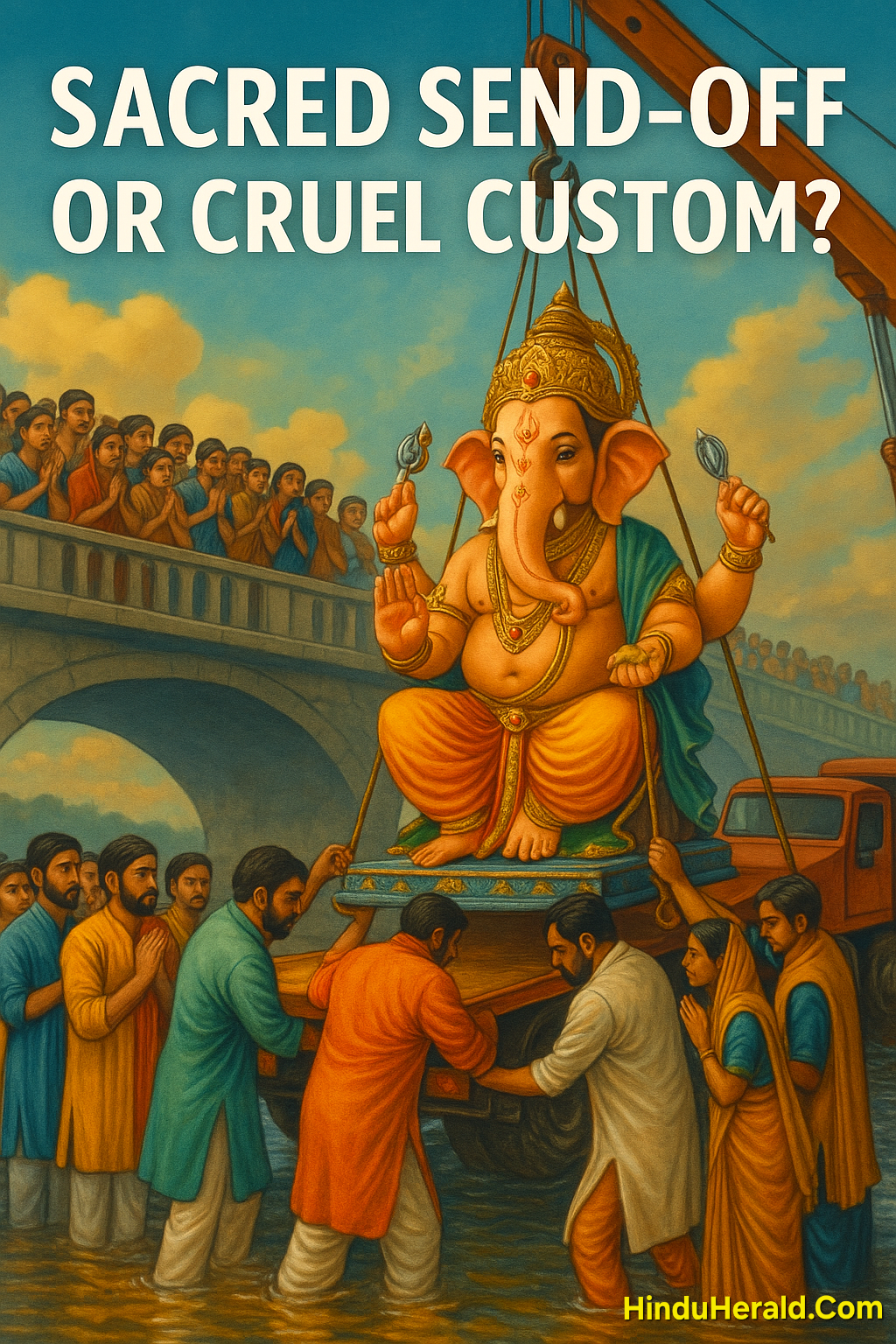
We Don’t Drown Our Gods: The Sacred Truth Behind Ganesh Visarjan
By Hindu Herald Staff
The drums shake the bridge. A giant Ganesha murti, taller than a bus, sways on ropes as dozens of men pull it toward the edge. Devotees chant Ganpati Bappa Morya! — some smiling, some sobbing. A small boy wipes his face with one hand while clutching a modak sweet in the other, his eyes locked on Ganesha’s painted smile. The crowd counts down. With one final heave, the murti is tipped and plunges into the river below.
“There go the Hindus drowning their god again.”
“Worship him one day, throw him away the next.”
“What kind of religion destroys its own deity?”
It’s mockery that stings — and it’s based on a complete misunderstanding. Even many Hindus don’t know the truth: by the time Ganesha hits the water during Ganesh visarjan (Ganesh immersion), He’s already gone.
The Ceremony Nobody Sees: Uttar Puja
Before the crowds gather and the murti is carried to the water, there is a quiet, intimate ritual that almost never makes it to social media. It’s called Uttar Puja — literally “the final worship.”
In this short but sacred ceremony, the priest — or the head of the household, if it’s a home puja — offers Ganesha his last round of flowers, incense, and prayers. Then, with specific mantras, they thank Him for accepting their devotion and request Him to return to His cosmic abode until He is invited again.
How it works
- Preparation — The murti is still decorated; fresh flowers are offered.
- Final Worship — Water, flowers, incense, lamp, food (naivedya) are offered, often with the Ganapati Atharvashirsha or Ganesha Ashtottara.
- Visarjana Mantras — The priest recites verses requesting the deity to depart, such as:
“Yāntu devā yathāsthānaṃ yathākālam yathāsuḷam | Punarāgamanāya cha sadā santu namo namaḥ”
(“May the gods return to their proper places, at the proper time, with ease. May they always return again — we bow to you.”) - Final Arati — A farewell lamp is waved before the murti.
- Removal of Ornaments — Flowers and garlands are taken off and given as prasada.
In Hindu ritual science, this is the reverse of prāṇa pratiṣṭhā — the ceremony that brought Ganesha’s life-force into the murti at the start of the festival. Uttar Puja is the respectful release of that life-force.
By the time the murti leaves the temple or home, the presence of Ganesha has already been respectfully sent back to His eternal abode. What is carried to the water in Ganesh visarjan is sacred matter, but no longer the living form of the Lord.
What the Scriptures Say
The Ganesh Purana calls Ganesha “beyond form, yet graciously accepting form for the sake of the devotee.” The form is a temporary vāhana — a vehicle for His presence during worship.
The Shaiva Agamas detail the steps: prāṇa pratiṣṭhā (inviting the divine), avāhana (daily invocation), and Uttar Puja / Visarjana (the formal farewell). The Skanda Purana gives a simple analogy: just as a guest is welcomed with water, flowers, and a seat, the guest is also respectfully escorted out when the visit ends. The murti is a seat — not the god Himself.
Why We Let Him Go
Ganesh visarjan (Ganesh immersion) is more than a farewell — it’s a reminder of anitya, impermanence. When Ganesha’s clay body melts into the water, it mirrors the journey of all forms:
- The body returns to the five elements (pancha bhuta).
- The soul — divine or human — returns to its eternal source.
It’s the cycle of srishti (creation) and pralaya (dissolution). Ganesha came from the earth, stayed as an honored guest, and now returns to the cosmic ocean, leaving blessings in His wake. That’s why devotees chant joyfully at Ganesh visarjan: “Pudhchya Varshi Lavkar Ya!” — “Come back soon next year!”
Tradition in a Modern World
Today, Ganesh visarjan — or Ganesh immersion — practices adapt to environmental realities:
- Eco-friendly clay and natural dyes.
- Artificial immersion tanks.
- Symbolic immersion with small clay replicas for homes.
- Permanent metal or stone murtis with only a ritual bath marking visarjan.
These changes keep the spiritual essence intact while protecting the earth. The point was never to “throw away” a god — it’s to return the vessel that once held His presence to the elements from which it came.
Common Misconceptions & How to Respond
Unfortunately, some people — often without understanding — mock Ganesh visarjan with crude or dismissive remarks. Here are some common ones, and how to answer them with clarity and confidence.
1) “It’s idol worship.”
No — it’s murti puja. “Idol” means false god. Our gods are not false — they are alive, real, and rule over the universe. A murti is simply a seat for the spirit of God to reside in so He can be offered worship. After invocation, God himself is present within the murti! The murti is like a king’s throne.
If you believe God is formless and present in the air element – then logic would dictate that he could also be present in the other elements, including earth which produces clay which forms murtis. You can’t say God is present in one element (air) and not in another (earth)!
2) “Hindus make their gods with their hands.”
No — we make seats for God with our hands. The murti is a seat for God, a receptacle for the spirit of God to reside in.
3) “Hindus drown their gods.”
Wrong. Ganesh is gone before the murti even touches the water! The spirit of God is formally asked to leave the murti during uttar puja. What is immersed in the water is just the seat or throne that God’s spirit once resided in. Ganesh already left before the murti even touched the water.
4) “They worship one day and throw away the next.”
We worship God within the murti. Once the spirit of God leaves the murti, it’s an empty vessel. We don’t throw God away. What’s immersed during Ganesh visarjan is the seat that God’s spirit no longer resides in.
5) “How can God be an elephant?”
God can take any shape He wants. It’s not up to man to dictate what form God can and can’t descend in. In the Bible, God took the form of a burning bush. I could flip the question and ask, “how can God be a plant”?
6) “Why can’t you keep Ganesh in your house?”
There are two types of murtis: the home murti & the festival murti. The home murti is always at home. The festival murti is solely for the festival. The Ganesh Chaturthi festival requires invocation of Ganesh, worship, then Uttar Puja and Ganesh visarjan. So immersion of the murti is a part of the festival – that’s why you can’t keep this murti.
7) It’s cruel to throw Ganesh in the water!
Ganesh is not in the water, the murti is. Ganesh’s spirit already departed the murti. What’s in the water is an empty vessel. It’s like if a loved one departs this world, you’d return their body to the elements, usually fire or earth. That would be the responsible, dignified thing to do. It’s the same thing here. The murti is made of clay and immersing it in water during Ganesh visarjan returns the murti to the water element.
Closing
So the next time you see a video of Ganesha “being drowned,” remember this: We are not “drowning” Him. We are returning the sacred vessel that once held His presence to the elements — because He has already been respectfully sent back to His eternal abode.
Ganesh visarjan is not about loss. It’s about completion. All forms are temporary, but the blessings of Ganesha are eternal.
You cannot drown the One who holds the universe in His hands.
Share this article to help fellow Hindus understand the sacred meaning of Ganesh visarjan — and so you can respond with confidence when trolls mock the tradition by saying we “drown” Ganesh.
© Hindu Herald



